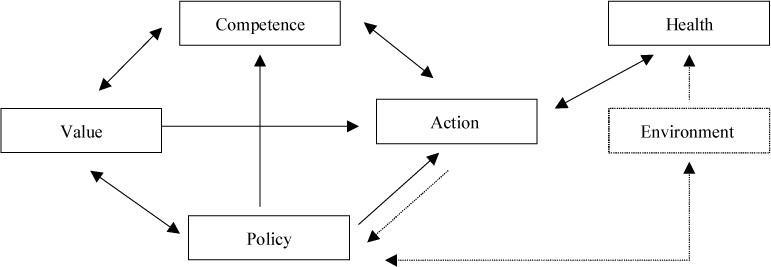J Korean Acad Community Health Nurs.
2010 Mar;21(1):92-100. 10.12799/jkachn.2010.21.1.92.
The Effect of a Health Promotion Program through Multi-level Health Promotion
- Affiliations
-
- 1Seoul Woman's College of Nursing, Korea. viva826@hanmail.net
- KMID: 2292916
- DOI: http://doi.org/10.12799/jkachn.2010.21.1.92
Abstract
- PURPOSE
This study was carried out to investigate the effects of improvement in self-rated health, self-efficacy, perceived benefit and health promotion behavior by running a health promotion program through the coalition of industries, universities and districts.
METHODS
This study was designed as non-equivalent control group research. Data were collected from 62 participants in a health promotion program who were enrolled in a community center (experimental group: 29, control group: 33). The program was applied from October to November, 2008. The health promotion program was composed of value, competence, action, and policy based on a multi-level health promotion model. Collected data were analyzed through chi2 test, t-test, and Wilcoxon test.
RESULTS
After participating in the health promotion program, the experiment group showed statistically significant increases in self-efficacy, perceived benefit and health promotion behavior but not in self-rated health.
CONCLUSION
It was proven that the health promotion program enhanced the health promotion level in the community.
Keyword
MeSH Terms
Figure
Reference
-
1. Antonovsky A. The salutogenetic model as a theory to guide health promotion. Health Promot Int. 1996; 11:11–18.2. Byon Y, Oak J. The relation between perceived health status and health-promoting behaviors in female college students. J Community Health Nurs. 2008; 19(4):715–723.3. Choi S. Factors associated with health behavior among mid-aged men in an area. Busan: Inje University;2002. Unpublished master's thesis.4. Cohen J. Statistical power analysis for behavioral science. Academic Press: New york;1988.5. Fleury J, Lee SM. The social ecological model and physical activity in african american women. Am J Community Psychol. 2006; 37:129–140.
Article6. Green L, Kreuter MW. Health promotion planning: An educational and environmental approach. 2nd ed. Mountain View, CA: Mayfield;1991.7. Grzywacz JG, Marks N. Social inequalities and exercise during adulthood: Toward an ecological perspective. J Health Soc Behav. 2001; 42:202–220.
Article8. Grzywacz JG, Fuqua MS. The social ecology of health leverage points and linkages. Behav Med. 2000; 26(3):101–115.
Article9. Lee T, Lee J, Kim H, Han O. Health behaviors between a health promotion demonstration health center and a general health center. J Korean Acad Nurs. 2005; 35(3):461–468.
Article10. Lee T. The analysis of effecting factors of health promotion in Seoul. Seoul: Yonsei University;1990. Unpublished master's thesis.11. Martinelli A. An explanatory model of variables influencing health promotion behaviors in smoking and nonsmoking college students. Public Health Nurs. 1999; 16(4):263–269.12. Moon J. A study of instrument development for health belief of Korean adults. Seoul: Younsei University;1990. Unpublished doctoral dissertation.13. Park HS, Cho G, Park K. The effect of an integrated health promotion program in middle-aged women. Korean J Women Health Nurs. 2004; 10(2):136–143.14. Park N, Han C, Choi E. The effects of a combined exercise program and telephone counselling on physiological functions, self-efficacy and depression in obeses middle-aged woman. J Korean Acad Community Health Nurs. 2007; 18(1):69–78.15. Pender NJ. Attitudes, subjective norms and intentions engage in health behavior. Nurs Res. 1986; 35:15–18.16. Rutten A, Lengerke T, Abel T, Kanas L, Luschen G, Diaz J, et al. Determinants of health promotion action: Comparative analysis of local voluntary association in four municipalities in Finland. Health Promot Int. 2000; 15(1):35–47.17. Simonsen-Rehn N, Lamanen O, Suominen S, Sundell J, Brommrls M. Policy, competence, and participation: Empirical evidence for a multilevel health promotionmodel. Health Promot Int. 2006; 21(4):274–283.18. Syme L. Social epidemiology and the work environment. Int J Health Serv. 1988; 18:635–645.
Article19. Ware JE, Sherbourne CD. The MOS 36-item short-form health survey (SF-36conceptual framework and item selection. Med Care. 1992; 30(6):473–483.20. Wen L, Thomas M, Jones H, Orr N, Moreton R, King L, et al. Promoting physical activity in women: Evaluation of a 2-year community-based intervention in Sydney, Australia. Health Promot Int. 2002; 17(2):127–137.
Article21. Whitehead D. Health promotion and health education: Advancing the concepts. J Adv Nurs. 2004; 47(3):311–320.
Article22. Yoo H, Park J. A chronic disease self-management program for the elderly in Korea. J Korean Acad Community Health Nurs. 2005; 16(4):404–414.23. Yoon TH. The proposal of policies aimed at tackling health inequalities in Korea. J Prev Med Public Health. 2007; 40(6):447–453.
Article24. Yoon HS. An analysis of the utilization of health promotion program in health care centers: Social ecological model. Seoul: Ewha Womans University;2007. Unpublished doctoral dissertation.25. Zakus JD, Lasack CL. Revisiting community participation. Health Policy Plan. 1998; 13:1–12.
- Full Text Links
- Actions
-
Cited
- CITED
-
- Close
- Share
- Similar articles
-
- Health Status, Healthy Behavior, and Health Promotion Program Needs of Industrial Male Workers according to Shift Work at an Workplace
- A Survey of Workplace Health Promotion Activities and their Health Promotion Program Need
- Structural Equation Modeling of Health Promotion Behavior on Migrant Workers: A Multi-Group Analysis Based on the Period of Residence
- The Effect of an Integrated Health-Promotion Program in Middle-Aged Women
- Effects of Fatigue on Health Promotion Behavior and Mental Health of Automotive Manufacturing Workers


